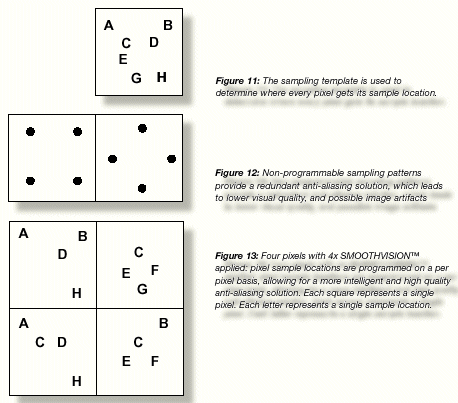GeForce3 Under Attack: ATi's Radeon 8500 Previewed
'SmoothVision' - Sophisticated Multi Sampling FSAA
The first time we heard of multi sampling full scene anti aliasing goes back to good old 3dfx and Voodoo 5, but the first chip with a sophisticated multi sampling FSAA was NVIDIA's GeForce3. Now ATi christened their more advanced MSFSAA-solution 'SmoothVision'. The trick of 'Smoothvision' is its programmability. The developer chooses the pattern that will be used for the multi-sampling.
Again, ATi improved a technology used in GeForce3. It is too bad that none of the Radeon 8500 press samples were able to run with 'SmoothVision' enabled, because then I might have been able to tell you a bit more about it or even show you some sample pictures. Basically, SmoothVision allows more flexibility than GeForce3's Quincunx, but it also requires some more work of the game developer. Radeon 8500 allows up to 16 different programmable sample modes and up to 16 samples per pixel for its FSAA. While 16 samples per pixel would obviously prove very costly in terms of rendering performance, Radeon 8500 gives developers the flexibility to choose the most attractive as well as most effective FSAA-method for their game.
Let me not forget that the multi-sampling support of Radeon 8500 also allows so extremely important stuff as depth-of-field or motion blur.
High Performance Memory And HyperZ II
We were very impressed with GeForce3's crossbar memory controller , which has the ability to use the available memory bandwidth much more effectively, as we will see in particular with NVIDIA's brand new Detonator 4 driver set. Radeon 8500 does not come with a solution quite as sophisticated, but its memory controller is also dividing the 128-bit memory interface. While GeForce3's crossbar controller splits the 128 data lines in 4 blocks with 32-bits each, Radeon's memory controller is using a two-channel design with two blocks of 64 bit to make data transfers more efficient. The memory controller is able to run with SGRAM as well as (DDR-) SDRAM, it can be equipped with 16 - 256 MB of memory and can run at a memory clock of up to 300 MHZ (600 MHz DDR). Our test sample was running its memory at 275 MHz (550 MHz DDR).
To save memory bandwidth as well, ATi improved Radeon's 'hidden surface removal' technique, summarized under the term "HyperZ". Radeon 8500 comes with an improved 'HyperZ II'. The idea behind it is still the same as with the original HyperZ (Fast Z-Clear, Z-Compression, Hierarchical-Z), but ATi improved (or rather fixed) the algorithms used by HyperZ. The result is rather impressive, as we will see in the VillageMark-scores of Radeon 8500.
Get Tom's Hardware's best news and in-depth reviews, straight to your inbox.
Current page: 'SmoothVision' - Sophisticated Multi Sampling FSAA
Prev Page 'SmartShader' - Another Programmable Vertex And Pixel Processor Next Page HydraVision - One High End Card With Two Displays